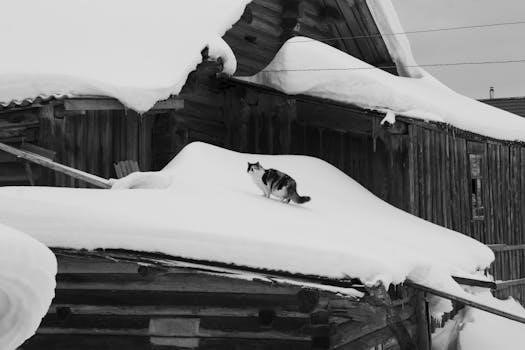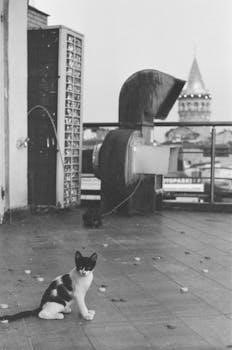
cat on the hot tin roof pdf
Cat on a Hot Tin Roof PDF⁚ An Overview
Free downloads of the play are available as PDF files‚ offering easy access to the text. These digital versions allow readers to explore the play’s context and summaries. Many sources provide online access‚ ensuring widespread availability.
Free PDF Downloads of the Play
Numerous online platforms offer free PDF downloads of Tennessee Williams’ “Cat on a Hot Tin Roof‚” making the play readily accessible to students‚ educators‚ and theatre enthusiasts. These digital versions provide a convenient way to study the script‚ explore its themes‚ and analyze character development. The availability of PDF formats ensures compatibility across various devices‚ enabling readers to engage with the play both at home and on the go. The digital format also allows for easy searching of specific passages‚ aiding in detailed textual analysis. Whether for academic research or personal enjoyment‚ accessing “Cat on a Hot Tin Roof” in PDF format opens up a world of opportunities for appreciating this iconic work of American drama. Such free access facilitates deeper engagement with the play’s complex characters and its exploration of truth‚ lies‚ and family dynamics. These resources offer a valuable tool for anyone seeking to understand and appreciate the nuances of Williams’ powerful play.
Availability of the Text Online
The full text of “Cat on a Hot Tin Roof” is widely available online‚ making it easily accessible for readers around the globe. Various websites and digital libraries host the play in different formats‚ including PDF‚ text files‚ and online readers. This broad availability ensures that students‚ researchers‚ and theatre lovers can easily access the play for study or personal enjoyment. Many educational platforms also offer the play as part of their online resources‚ often accompanied by supplementary materials such as character analyses and critical essays. The digital accessibility of “Cat on a Hot Tin Roof” breaks down geographical barriers‚ allowing anyone with an internet connection to engage with this important piece of American theatre. Moreover‚ the online presence of the text facilitates sharing and collaboration‚ enabling students and scholars to discuss and explore the play’s themes and nuances. This widespread accessibility is a testament to the enduring relevance and power of Tennessee Williams’ work.

Character Analysis in Cat on a Hot Tin Roof
The play delves into complex characters‚ such as Brick Pollitt‚ filled with disgust‚ and Maggie‚ struggling in a childless marriage. Big Daddy also observes the ‘cats on a hot tin roof’ dynamic of the family.
Focus on Brick Pollitt’s Disgust
Brick Pollitt’s character is significantly defined by his profound sense of disgust‚ a central theme explored throughout “Cat on a Hot Tin Roof.” This disgust isn’t merely a personal quirk; it’s a deep-seated reaction to what he perceives as the pervasive falsehood and hypocrisy surrounding him. His feelings are rooted in a belief that he is one of the few honest individuals‚ which causes him to feel alienated and cynical towards others. This feeling of disgust affects his relationships and fuels his alcoholism‚ creating a vicious cycle of self-loathing and withdrawal. His disgust also stems from a perceived lack of authenticity in the relationships around him‚ particularly his marriage and his family’s materialistic obsession with the plantation; The play uses Brick’s disgust as a lens through which to examine the themes of truth‚ deception‚ and the struggle to find genuine connection in a world filled with pretense. This character trait becomes essential to understanding his actions and motivations within the narrative.
Maggie’s Childless Marriage Struggles
Maggie’s struggles within her childless marriage to Brick are a core element of “Cat on a Hot Tin Roof‚” highlighting the immense pressure she faces. Her marriage is defined by a profound lack of intimacy and physical connection‚ exacerbated by Brick’s emotional detachment. The absence of children in their marriage is not simply a personal disappointment for Maggie; it becomes a symbol of their fractured relationship and her vulnerability within the family dynamics. This inability to conceive adds to her frustration and desperation‚ as she is constantly reminded of her perceived inadequacies. Her childless state is often used by other characters‚ notably Mae‚ as ammunition against her‚ highlighting the societal expectations placed upon women. This struggle drives much of Maggie’s manipulative behavior and her relentless pursuit of Brick’s affection‚ as she sees their marriage and the inheritance of the plantation as her only means of securing her future. Her childless marriage becomes a battleground for her self-worth and survival.
Big Daddy’s Observation About ‘Cats on a Hot Tin Roof’
Big Daddy’s colorful observation about “cats on a hot tin roof” encapsulates the central tension and discomfort within the play. He uses this metaphor to describe the strained interactions and unease he perceives among his family members‚ particularly Maggie and Brick. His comment highlights the superficiality and underlying anxiety that permeates their relationships. The image of cats on a hot tin roof perfectly captures the feeling of being trapped in a stressful and precarious situation‚ where each character struggles to maintain their footing and position. Big Daddy’s observation underscores the constant agitation and discomfort that characters experience in their pursuit of control‚ affection‚ and inheritance. The phrase serves as a lens through which the audience can interpret the characters’ desperation and the overall atmosphere of simmering conflict. This metaphor also provides a darkly comedic element‚ adding to the play’s complex portrayal of family dynamics and dysfunction. Big Daddy‚ with his keen observations‚ identifies the raw‚ exposed nerves of his family.

Themes and Context of Cat on a Hot Tin Roof
The play is a turbulent and brutal comic drama by Tennessee Williams. It is set in the Mississippi Delta‚ focusing on a wealthy plantation. The story explores themes of family dysfunction and underlying tensions.
Turbulent and Brutal Comic Drama
Tennessee Williams’ “Cat on a Hot Tin Roof” is indeed a turbulent and brutal comic drama‚ a description that perfectly encapsulates the intense emotional landscape within the play. The narrative unfolds with a raw honesty‚ exposing the deep-seated conflicts and hidden resentments festering beneath the surface of the seemingly affluent Pollitt family. The play masterfully blends elements of dark humor with profound tragedy‚ creating a theatrical experience that is both captivating and disturbing. The characters are not merely caricatures‚ but complex individuals grappling with their own demons and desires‚ leading to confrontations that are often volatile and emotionally charged. The dialogue is sharp and witty‚ yet it also reveals the underlying pain and desperation that drive their actions. This dramatic tension‚ coupled with the play’s intense emotional core‚ is what makes it a truly memorable and impactful work of theatre‚ demonstrating Williams’ incredible ability to craft a narrative that is both entertaining and profoundly thought-provoking. The comedic aspects serve to highlight the absurdity of their situations‚ making the brutal realities all the more poignant.
Setting in the Mississippi Delta
The setting of “Cat on a Hot Tin Roof” in the Mississippi Delta is far more than just a backdrop; it’s an integral part of the play’s themes and atmosphere. The sweltering heat and languid pace of the Delta contribute to the sense of simmering tension and repressed emotions that permeate the narrative. The wealthy plantation setting‚ with its veneer of Southern gentility‚ contrasts sharply with the underlying decay and dysfunction within the Pollitt family. This juxtaposition amplifies the play’s exploration of truth and illusion‚ as the characters struggle to maintain appearances while grappling with their inner conflicts. The physical environment mirrors the characters’ psychological states‚ creating a claustrophobic and oppressive atmosphere that intensifies their struggles. The sense of stagnation and decay that is present in the landscape reflects the emotional paralysis that afflicts many of the characters‚ further emphasizing the play’s themes of mortality and legacy. The Delta setting‚ therefore‚ becomes a crucial element in shaping the dramatic landscape of the play.

Study and Analysis Resources
Resources for drama and theatre students often explore Benedict Andrews as a contemporary theatre practitioner. These resources can be invaluable for studying “Cat on a Hot Tin Roof‚” providing critical insights and analysis.
Benedict Andrews as a Contemporary Theatre Practitioner
Benedict Andrews‚ a notable contemporary theatre practitioner‚ often provides a modern lens through which classic plays like “Cat on a Hot Tin Roof” can be re-examined. His approach to theatre often involves a raw and unflinching exploration of human relationships‚ making his work particularly relevant to the themes present in Williams’s play. Andrews’s interpretations can shed light on the complexities of the characters‚ their motivations‚ and the societal pressures that shape their actions. His work encourages audiences to engage with the play on a deeper level‚ considering the contemporary resonance of its themes. By studying Andrews‚ students can gain a fresh perspective on the text‚ moving beyond traditional interpretations. His focus on the emotional core of the drama helps to highlight the brutal honesty and turbulent nature of the play‚ making it a valuable resource for those seeking to understand the complexities of human interactions portrayed within “Cat on a Hot Tin Roof”. His innovative staging and direction bring a new dimension to the classic text‚ making it accessible to modern audiences and prompting insightful discussions.
Exploration of Drama and Theatre Student Resources
For drama and theatre students studying “Cat on a Hot Tin Roof‚” a wealth of resources is available to enhance their understanding and analysis of the play. These resources include critical essays‚ scholarly articles‚ and various online materials that delve into the play’s themes‚ characters‚ and historical context. Students can explore different interpretations of the text and examine its significance within the broader context of American drama. Many educational websites and databases provide access to study guides and lesson plans‚ designed to facilitate in-depth discussions and analysis. Furthermore‚ resources focused on theatrical production‚ such as stage design and performance theory‚ can aid students in understanding the play’s performance aspects. Examining the play through different perspectives allows students to develop their own critical lens and appreciate the complexities of the drama. Accessing these resources enables students to gain a well-rounded perspective‚ fostering a deeper understanding of both the written text and its theatrical potential. These tools are invaluable for creating informed and engaging theatrical analyses.

Specific Textual Details
Mae’s dialogue reveals her manipulative nature‚ often using “honey” to mask her true intentions. The Digital Library of India provides access to a source‚ offering a deeper look into the play’s original text and context.
Mae’s Dialogue in the Play
Mae’s dialogue in “Cat on a Hot Tin Roof” is a masterclass in passive-aggressive manipulation‚ often cloaked in a veneer of Southern charm. Her use of the endearment “honey‚” frequently directed towards Maggie‚ is a prime example of her two-faced nature. While she may appear sweet and concerned on the surface‚ her words often carry a sharp‚ cutting edge‚ designed to undermine and provoke. Mae’s interactions with other characters‚ particularly with Maggie‚ reveal her deep-seated jealousy and ambition. She is determined to secure her family’s position within Big Daddy’s estate and will use any means necessary‚ including subtle jabs and veiled threats‚ to achieve her goals; Her conversations are loaded with double meanings‚ making her a complex and intriguing character. She is portrayed as manipulative and conniving‚ trying to get her own way through subtle‚ yet very deliberate‚ means of communication. Her speech patterns and word choices highlight the underlying tensions and power struggles within the family. Through Mae’s dialogue‚ Williams effectively showcases the corrosive effects of greed and familial rivalry.
Digital Library of India Source
The Digital Library of India serves as a valuable resource for accessing the text of “Cat on a Hot Tin Roof‚” offering a digitized version of the play that allows for scholarly study and research. The specific item‚ identified as 2015.460905dc‚ provides a direct link to the play‚ preserving its original form and ensuring its availability to a wide audience. This digital preservation is crucial for maintaining access to classic literary works like those of Tennessee Williams. The library’s contribution is particularly important for those who may not have access to physical copies‚ making the play more accessible for students‚ researchers‚ and enthusiasts globally. The resource allows for a deeper exploration of the play’s nuances and historical context. Furthermore‚ the fact that the play is cataloged within the Digital Library of India indicates its significance as a work that transcends geographical and cultural boundaries. The source provides the ability to delve into the literary merit of the play‚ its themes and character development. It ensures that the play is readily available.